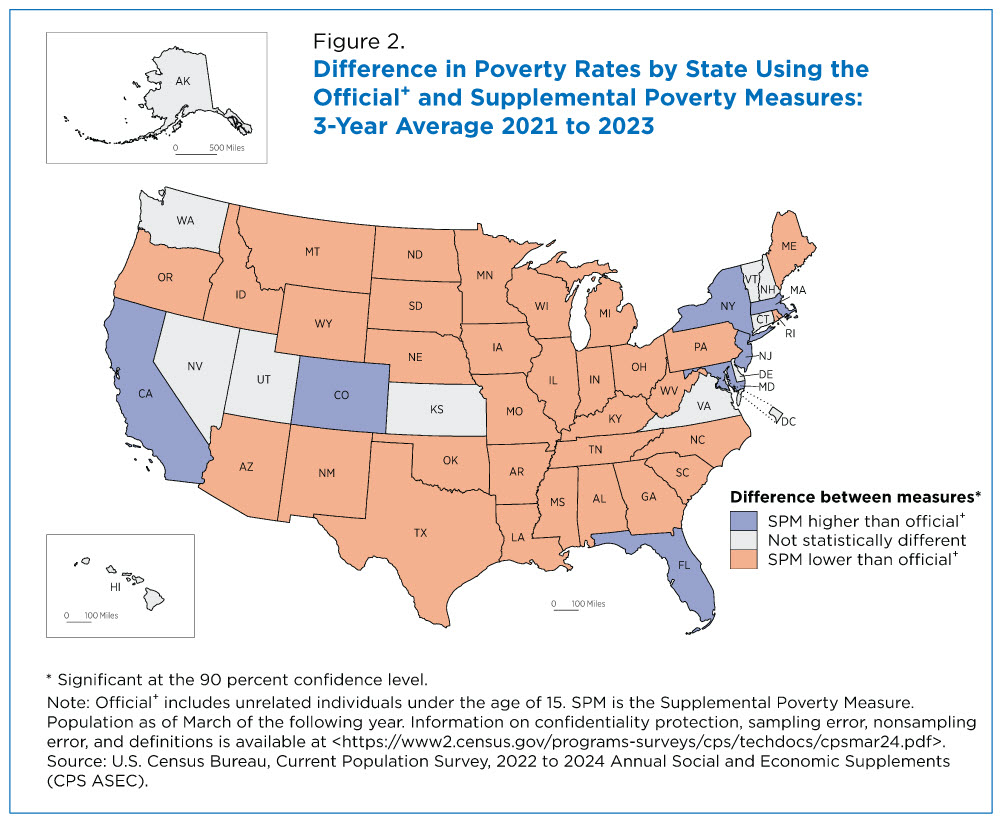Differences Between Poverty Measures May Reflect Differences in Housing Costs or Noncash Benefits Across States
The national official poverty rate (11.1%) was lower than the Supplemental Poverty Measure (SPM) (12.9%) in 2023, according to the U.S. Census Bureau’s report, Poverty in the United States: 2023, released today.
However, an analysis of 3-year averages of poverty rates by states shows the SPM rate was lower than the official rate in 32 states.
SPM rates may be higher in some states for several reasons, from differences in housing costs and homeownership rates to higher taxes or medical expenses.
The two poverty measures provide distinct indicators of U.S. economic well-being.
The SPM broadens the official poverty measure by accounting for government programs designed to assist low-income families that are not included in the official poverty measure while also including federal and state taxes and necessary expenses.
The SPM also considers geographic variation in housing costs and housing tenure (whether one rents or owns their home with or without a mortgage) in poverty thresholds, while the official poverty measure does not.
The Current Population Survey Annual Social and Economic Supplement (CPS ASEC) is the official source of national poverty estimates. To create state-level estimates, the Census Bureau recommends using 3-year averages for additional statistical reliability.
Figure 1 details 3-year average poverty rates for each state from 2021 to 2023 for the SPM and the official poverty measure, which for this analysis includes unrelated individuals under 15 (hereafter referred to as the official+ poverty measure).
The national 3-year average official+ poverty rate from 2021 to 2023 was 11.4% compared to the SPM rate of 11.0%, a 0.4 percentage point difference.
In 2021, the national SPM rate was its lowest rate at 7.8% (SPM rates are available going back to 2009) while 2022 and 2023 national poverty rates were 12.4% and 12.9%, respectively.
Meanwhile, the annual official+ poverty rate ranged from 11.1% to 11.6% between 2021 and 2023 (the 2021 and 2022 rates are not statistically different).
Utah was among the states with the lowest official+ poverty rate (6.7%) and Louisiana among the states with the highest (18.9%).
Maine had one of the lowest SPM poverty rates (5.9%) and California had one of the highest (15.4%).
More official and SPM rates by states and by major age categories can be found in today’s release.
Figure 2 maps the differences between the two measures.
SPM rates may be higher in some states for several reasons, from differences in housing costs and homeownership rates to higher taxes or medical expenses.
Seven states had a higher SPM rate than official+ poverty rate: California, Colorado, Florida, Maryland, Massachusetts, New Jersey and New York.
The official+ poverty rate exceeded the SPM rate in 32 states: Alabama, Arizona, Arkansas, Georgia, Idaho, Illinois, Indiana, Iowa, Kentucky, Louisiana, Maine, Michigan, Minnesota, Mississippi, Missouri, Montana, Nebraska, New Mexico, North Carolina, North Dakota, Ohio, Oklahoma, Oregon, Pennsylvania, Rhode Island, South Carolina, South Dakota, Tennessee, Texas, West Virginia, Wisconsin and Wyoming.
Finally, the rates weren’t statistically different in the District of Columbia and 11 states: Alaska, Connecticut, Delaware, Hawaii, Kansas, Nevada, New Hampshire, Utah, Vermont, Virginia and Washington.
Poverty in the United States: 2023 provides more details on the impacts of policies and programs on the SPM rate.
The technical documentation page includes information on confidentiality protection, methodology, sampling and nonsampling error. All comparative statements have undergone statistical testing and are statistically significant at the 90% confidence level unless otherwise noted.
Related Statistics
Subscribe
Our email newsletter is sent out on the day we publish a story. Get an alert directly in your inbox to read, share and blog about our newest stories.
Contact our Public Information Office for media inquiries or interviews.
-
HealthHow Age and Poverty Level Impact Health Insurance CoverageSeptember 10, 2024The percentage of people without health insurance remained around 8% in 2023 but rates varied by age and poverty level, according to data released today.
-
Income and PovertySupplemental Poverty Measure Rose in 2023 for Second Consecutive YearSeptember 10, 2024The SPM, which accounts for noncash government assistance, increased to 12.9% in 2023, higher than pre-pandemic levels.
-
Income and PovertyMedian Household Income Increased in 2023 for First Time Since 2019September 10, 2024Non-Hispanic White households were the only group with higher incomes in 2023. Asian household median income remained the highest among all groups.
-
EmploymentThe Stories Behind Census Numbers in 2025December 22, 2025A year-end review of America Counts stories on everything from families and housing to business and income.
-
Families and Living ArrangementsMore First-Time Moms Live With an Unmarried PartnerDecember 16, 2025About a quarter of all first-time mothers were cohabiting at the time of childbirth in the early 2020s. College-educated moms were more likely to be married.
-
Business and EconomyState Governments Parlay Sports Betting Into Tax WindfallDecember 10, 2025Total state-level sports betting tax revenues has increased 382% since the third quarter of 2021, when data collection began.
-
EmploymentU.S. Workforce is Aging, Especially in Some FirmsDecember 02, 2025Firms in sectors like utilities and manufacturing and states like Maine are more likely to have a high share of workers over age 55.






